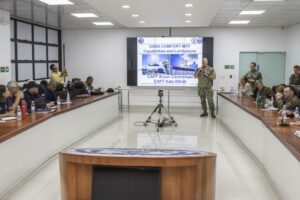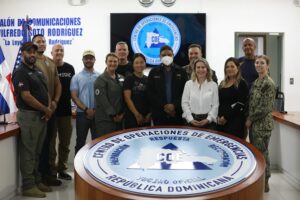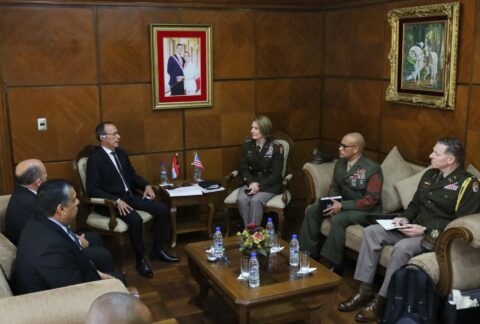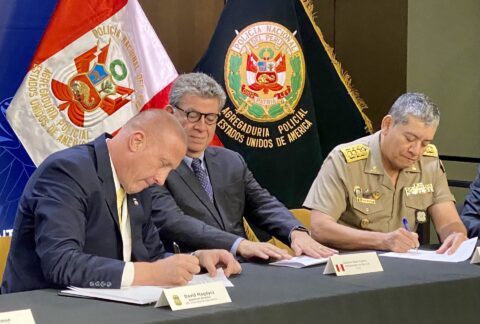The Dominican Republic and U.S. military forces, along with 911 operators, police officers, paramedics, emergency medical technicians, firefighters, and other first responders, participated in the Humanitarian Assistance/Disaster Relief (HA/DR) seminar at the Emergency Operational Center (COE) in Santo Domingo, Dominican Republic, December 1.
The seminar was part of the activities of U.S. Navy hospital ship USNS Comfort’s visit to the Dominican Republic. The ship is deployed to U.S. Naval Forces Southern Command/U.S. 4th Fleet in support of Continuing Promise (CP) 2022, a humanitarian assistance and goodwill mission conducting direct medical care, expeditionary veterinary care, and subject matter expert exchanges in five partner nations in the Caribbean, Central and South America.
“It’s critical to strengthening and building the relationships and the enduring promise between the U.S. and partner nations. It’s an absolute honor and a privilege working side by side with the dedicated professionals from the different organizations that are key disaster response personnel within the Dominican Republic,” said U.S. Navy Lieutenant Commander Jennifer Groger, Amphibious Squadron (PHIBRON) Four,HA/DR’s lead for the CP mission. “It helps build upon the foundation and the techniques that have already been established within the country.”
The HA/DR agenda included presentations of USNS Comfort capabilities, U.S. Agency for International Development’s Bureau of Humanitarian Assistance, and an earthquake tabletop exercise moderate by the Pacific Disaster Center, among others. Simultaneously, other first responders attended first aid training, including helicopter hoisting and medevac sessions using the U.S. Army UH-60LBlack Hawk helicopter assigned to USNS Comfort.

“The participants are very engaged. They’re very passionate about their jobs and their representation in civil society and how they would integrate. This exercise is important to do between the U.S. and the Dominican Republic as we want to be able to practice this ahead of time before you have to carry it out for real,” said U.S. Navy Rear Admiral Larry LeGree, Joint Interagency Task Force South’s deputy director, who was observing the tabletop exercise. “Continuing Promise shows the long term success of the partnership with the Dominican Republic and it demonstrates the long term commitment for the future.”
During the HA/DR event, participants from both nations exchanged experiences and challenges from response actions in specific missions. In addition, they talked about steps for emergency response drills and actions taken during events such as the COVID-19 response.
U.S. support in preparedness
Dominican Army Major General (ret.) Juan Manuel Méndez García, COE director, spoke about the importance of the HA/DR training for his organization. COE coordinates all actions among the institutions of the National Disaster Prevention, Mitigation, and Response System.
“It is extremely important for us to carry out this exercise, because, in effect, it allows the agencies to receive fresh information and training […]. We took advantage of the visit of the USNS Comfort because it has the magnitude and capacity to respond to situations in the event of a crisis in a country,” said Maj. Gen. Méndez.
The COE director recalled that communication is first to collapse in an emergency situation, and emphasized the importance for emergency operations centers to coordinate and have plans in place.
Maj. Gen. Méndez said that COE received technical advice from U.S. Southern Command and other federal agencies in the creation of their first earthquake contingency plan in 2009. A year later, in January 2010, following the earthquake in Haiti, the Dominican Republic and the COE served as a platform to support its neighbor in their emergency response.

Thanks to U.S. support, he added, in addition to a plan for the hurricane season, they have a contingency plan for earthquake, forest fires, and meteorological events that produce emergency situations such as frontal systems.
Michael “Chris” Schaff, a member of the diplomatic Mobile Security Deployment (MSD) team, a specialized tactical unit of the U.S. Department of State, was one of the subject matter experts on disaster response.
“If there’s a natural disaster or manmade disaster, then we have the ability to support or help the embassies with recovery or rescues and interaction that would take place after an event,” said Schaff. “It’s been a great opportunity for us to participate and to share some of that knowledge. We try and show them some of the best practices through multiple organizations that are participating here to be able to train as much as possible.”
José Cordero, engineer at the Dominican National Office of Seismic Evaluation and Vulnerability of Infrastructure and Buildings, believes that all HA/DR events raise awareness on how to give an effective response in the face of a disaster.
“We are in the hurricane routes; for example, every year we have the cyclonic season and we have two seismic zones, one of high seismicity and one of medium seismicity. That is to say, there is no area of the Dominican Republic that is not considered seismic, so we have a high risk of an event occurring very similar to the one that happened in Haiti in 2010 […].”
Cordero warned that some of the country’s infrastructure is built near seismic fault lines and that the sites’ conditions would likely be affected by strong earth tremors.
“We are not exempt from a disaster happening at any time because nature is good and we cannot define its actions, we cannot estimate how it may act; it’s unpredictable,” said Cordero. “But if we are prepared, we can mitigate the effects that it [nature] cannot for us. So, with this type of exercise, the community can know if we are really prepared,” Cordero added.









